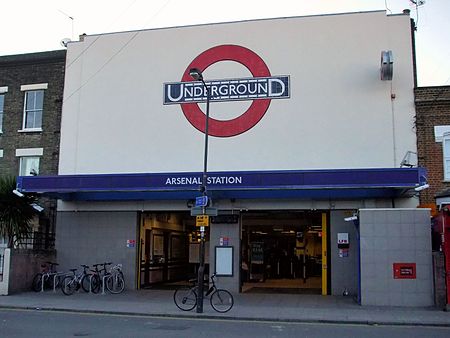Arsenal tube station
Arsenal F.C.Former Great Northern, Piccadilly and Brompton Railway stationsLondon Underground Night Tube stationsPiccadilly line stationsRail transport stations in London fare zone 2 ... and 4 more
Railway stations in Great Britain opened in 1906Railway stations located underground in the United KingdomTube stations in the London Borough of IslingtonUse British English from August 2012

Arsenal is a London Underground station located in Highbury, London. It is on the Piccadilly line, between Holloway Road and Finsbury Park stations, in Travelcard Zone 2. Originally known as Gillespie Road, it was renamed in 1932 after Arsenal Football Club, who at the time played at the nearby Highbury Stadium. It is the only tube station named directly after a football club. Although Highbury Stadium closed in 2006, the station retains its name and is still used by spectators attending matches at Arsenal's nearby Emirates Stadium.
Excerpt from the Wikipedia article Arsenal tube station (License: CC BY-SA 3.0, Authors, Images).Arsenal tube station
Drayton Park, London Finsbury Park (London Borough of Islington)
Geographical coordinates (GPS) Address Nearby Places Show on map
Geographical coordinates (GPS)
| Latitude | Longitude |
|---|---|
| N 51.558611111111 ° | E -0.10583333333333 ° |
Address
Gillespie Park Nature Reserve
Drayton Park
N5 1LU London, Finsbury Park (London Borough of Islington)
England, United Kingdom
Open on Google Maps








